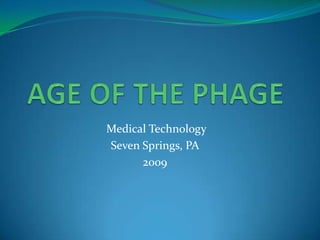
Age Of The Phage
- 1. Medical Technology Seven Springs, PA 2009
- 2. How to successfully integrate genetically engineered DNA into human cells that cure and prevent a variety of diseases in addition to other medical uses.
- 3. To use phages and their unique characteristics as vectors or “biological transporting agents” to inject desired DNA into humans and allow the desired strands to spread. Often the term phage therapy is used to describe the therapeutic use of phages to treat bacterial infections.
- 4. A bacteriophage or a virus is a nonliving specimen that infects cells of a host organism. The term is often referred to in its shortened form, phage.
- 5. Phages are usually composed of an outer protein capsid that takes the shape of an icosahedron which contains genetic material. The genetic material can be one of many forms of DNA or RNA. A collar, sheath, base plate, and trail fibers are also common structural components of a typical phage.
- 7. Phages are considered to be nonliving because: 1. They are incapable of growth and development 2. They do not have the cellular machinery required for reproduction Phages inject their DNA or RNA into a host organism’s cells and allow the host organism's cellular machinery to replicate the phage’s genetic material. The newly replicated genetic material codes for the creation of proteins for the construction of new phages. The host cell carries out this process of protein synthesis. Once new phages have accumulated within the host cell they often kill it and spread to new host cells.
- 8. Phages can be used to transfer and spread selected DNA that codes for the destruction of a deadly genetic illness, the prevention against a harmful disease, or the accelerated growth of damaged tissues throughout the human body. In this sense there are virtually endless possibilities for the application of phages. They are the future of modern medicine and some scientists predict they will become an unprecedented contributor to the destruction of many harmful diseases across the planet.
- 9. The procedure for using phages for medicinal purposes is actually simpler than previously thought. This simplicity can be credited to the fact that most of the procedure is composed of natural biological process with no human interference. The only human contribution is to initiate the process.
- 10. Identify the undesirable disease or bacterial infection. There are many diseases and infection that phage therapy can possibly treat. Determining the exact medical condition that a patient has before treatment is vital to the success of the therapy. Otherwise the therapy could potentially have disastrous and even lethal effects.
- 11. Obtain DNA that codes for the proper treatment The DNA strand should either have the capability of removing/destroying the targeted problem or creating new generations of cells that are resistant to the disease or infection. The DNA can be genetically engineered using modern techniques or removed and copied from another species
- 12. Place the engineered DNA into the phage and allow it to reproduce along with its new DNA. Reproduction can either occur through prophage or lytic pathways.
- 13. HOST CHROMOSOME CELL ATTCHMENT TO HOST CELL LAMDA AND INJECTION OF DNA VIRUS/PHAGE LAMDA DNA RECOGNIZED AND ORGANIZED BY CELL INTEGRATION OF SYNTHESIS OF VIRUS LAMDA DNA PROTEINS NEEDED FOR INTO HOST FORMATION OF NEW CHROMOSOME VIRUSES RAPID REPLICATION OF LAMBA DNA AND ITS PACKAGING INTO COMPLETE VIRUSES/PHAGES CELL DIVISION CELL LYSIS RELEASES A LARGE NUMBER OF NEW VIRUSES/PHAGES LYTIC PATHWAY PROPHAGE PATHWAY
- 15. The prophage procedure is when the patient is injected with a small number of phages and the body reproduces them in order to spread throughout the body. Pro-The number of phages produced by the body will always be adequate for the therapy. Con-After enough phages are produced it is difficult to stop them from killing cells and reproducing further. The lytic procedure is when the patient is injected with a very large number of phages that reproduced outside the body in a controlled environment using bacteria. Pro-The phages will not have to reproduce within the body do to their abundance Con-Calculating the initial amount of phages required for treatment and the frequency of their successful injection of genetic material is difficult to determine
- 16. Infect the patient with the phages. The biological processes of the human body and the phage will occur and the desired genetically engineered strand will spread throughout the body. Important biological/cell processes important to phage therapy include: -DNA replication -Protein Synthesis -Mitosis
- 18. Phages are much more specific than common drugs and other medical practices. Phages can be designed not only to be harmless to the host but also to beneficial bacteria. They are easy to obtain and reproduce. Phages are estimated to be the most widely distributed and diverse entities in the biosphere.
- 19. Bacterial Infections (Such as MRSA) Genetic Disorders *Cancer Variety of diseases -Common Cold -Viral pneumonia -Hepatitis -West Nile Disease -Norovirus
- 20. Not only can phage technology be used for medicinal purposes but also for crops and livestock. Using phages in this regard will have a profound impact on the environment, economy, and society as a whole. Ethical implications to consider: -Doctors knowing about phage therapy and deciding not to use an alternate form of treatment. This could be construed as very serious professional misconduct if the alternate form of treatment fails. -Phage therapy could treat a medical condition, but doctors were prevented from using it due to financial constraints.
- 21. “Imagination is more important than knowledge.” We have obtained the knowledge. Now all we have to do is imagine the possibilities.